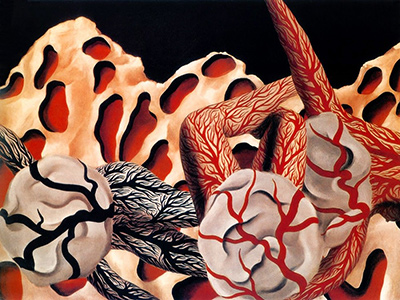Magritte's Blood of the World is a rather unusual piece; however, it is very compelling. Magritte's style as seen in The Blood of the World was not continued any later than 1930.
The Blood of the World depicts what appear to be skinned parts of the human body and are surrounded by what appear to be enlarged internal structures of the human body.
The way in which Magritte paints this is a great representation of the dark and dismal times he had in his life; of the battles and demons he fought. Although many of Magritte's paintings do this, it seems more apparent in the case of The Blood of the World and has often been questioned if the piece directly relates to the death of his mother.
The theme of death is one we see in various other works by Magritte, The Menaced Assassin being one of those pieces. Death is prominent in the scene of The Menaced Assassin. The lifeless naked body of a woman is portrayed in the middle of a room. Her murderer is present.
Although The Blood of the World does not show death as obviously as The Menaced Assassin shows the audience, it does so in an arguably more sinister way. The idea that death is within us could represent the idea of internal demons and inner troubles that cannot be seen to the outside world; this is another theme popular with Magritte.
In the case of The Blood of the World, Magritte also reinforces the idea of death being brutal by painting the body parts as if they were skinned. Reminding the reader that death is not always peaceful and that it is in fact often cruel or brutal, as his mother's suicide must have also unfortunately been.




